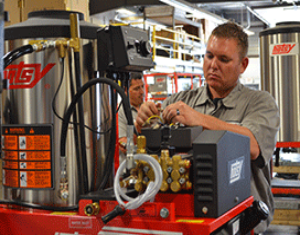Pressure Washer Repair in San Antonio
Keep Your Equipment Running Smoothly With the Experts in Pressure Washer Repair in San Antonio!
If you’re pressure washer hasn’t been working as well as you’d like, you may need commercial pressure washer maintenance. Or, perhaps your equipment has stopped working altogether and you need rapid commercial pressure washer repair in San Antonio.
Either way, you’re in the right place. Hotsy Equipment of San Antonio is a factory-authorized Hotsy warranty center for pressure washer repair. We have genuine Hotsy replacement parts in stock today to get you back up and running.
We understand that downtime is costing you money, and you need a reliable pressure washer service that can get your equipment back up and running fast. If we don’t have the right replacement pressure washer part in stock, we’ll order it with next-day air if needed.
We truly service what we sell and repair the equipment that others sell. You can even rely on our industrial pressure washer rentals in the meantime if you have a job that can’t wait.
When you trust Hotsy Equipment Company in San Antonio, you are never without a resource to get your cleaning equipment back up and running.
Request Service
Common Pressure Washer Repair Jobs
Pressure washers are powerful tools that undergo a lot of wear and tear, especially in a commercial setting. Over time, even the most durable machines may need repairs to stay in top working condition:
- Water Spraying from the Relief Valve: This safety feature can start leaking water if there’s an issue with the pressure buildup in the pump. It’s crucial to address this promptly to prevent damage to the pump and ensure safe operation.
- Pressure Washer Engine Problems: Engines can suffer from a variety of issues, including starting difficulties, irregular running, and unexpected shutdowns. These problems can stem from fuel system issues, spark plug malfunction, or air filter clogs.
- Weak Pressure Issues: If your pressure washer is not delivering the expected pressure, it could be due to worn nozzles, a faulty pump, or an inadequate water supply. A professional diagnosis can pinpoint the exact cause and remedy the situation.
- Burner Replacement: For hot water pressure washers, the burner is essential for heating the water. Over time, burners can fail and need replacing to maintain the effectiveness of the cleaning process.
- Pump Replacement: The pump is the heart of the pressure washer, and if it breaks down, you may experience low pressure or no pressure at all. Replacing a damaged pump can restore the machine’s functionality.
- Clogged Wands: Debris can accumulate in the wand, leading to reduced pressure and spray pattern issues. Cleaning or replacing the wand can resolve these problems.
- Broken Unloader Valves: The unloader valve directs water flow when the trigger isn’t engaged. A broken valve can cause pressure issues and should be replaced to avoid further damage.
- Oil Leaks and Thermal Release Issues: Oil leaks can indicate seal wear or other internal problems, while thermal release valves may malfunction, leading to overheating. Both require immediate attention to prevent more severe issues.
- Clogged Hoses or Inlet Filters: Debris and mineral buildup can clog hoses and filters, restricting water flow and reducing pressure. Regular cleaning or replacement of these components is necessary for optimal performance
Optimize Equipment Performance With Routine Pressure Washer Maintenance
A commercial pressure washer maintenance plan is something to consider if you own a commercial pressure washer that’s used often.
Scheduled maintenance programs keep your pressure washer working properly. They’re a cost-effective way to lengthen the life of your equipment considerably.
Don’t suffer with equipment problems – call today to schedule a service call for your pressure washer. Whether you have an industrial hot water pressure washer in San Antonio, an industrial cold water pressure washer in San Antonio, or even an industrial pressure washer trailer in San Antonio, this is an investment in peace of mind!
Schedule Your Pressure Washer Service or Repair at Hotsy of South Texas Today!

